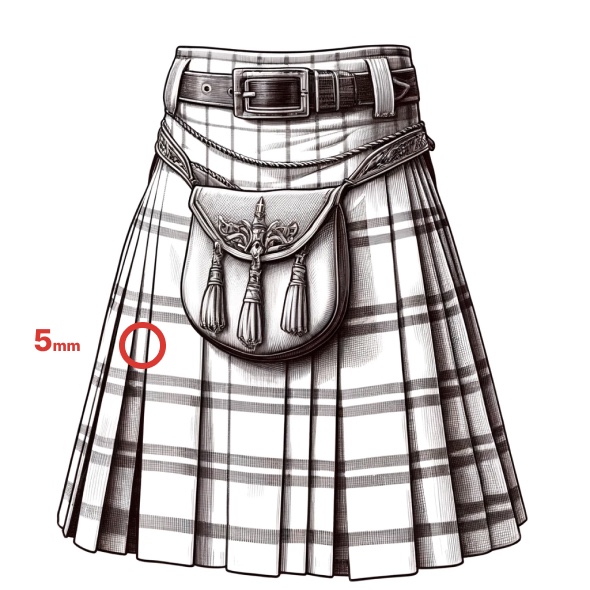
Repair 5mm Hole
#welovekilts and just like us, they come with a few battle scars as you don’t wear a kilt to the library!
If you’ve caught your kilt on a Tarrag (Gaelic for nail) then we’ll work our magic and repair it but remember, the Kiklt Doctor is a genius, not a miracle worker and some holes may still be visible.
£65.00
Repair Times
All repairs are carried out within 28 days as standard.
Skip the queue and have your repair faster for an additional fee:
Standard (28 days) - no extra charge

Express (14 Days)
£39.00

Super Express (7 Days)
£59.00
Repair Hole In Kilt
If your kilt has suffered an injury, the thread has come loose or you have moth holes, we can help repair kilt holes at The Kilt Doctor's workshops in Scotland.
Moths are the most common cause of holes in kilts. Moth holes can vary in size from very tiny and barely noticeable to quite large, even as much as 10cm across. With ware, small moth holes can quickly become larger moth holes as the thread and cloth wear out.
We repair holes either by re stitching the hole with a needle (darning) or by using new tartan cloth fabric to tie into the existing fabric if the moth hole is large enough.
When the hole is repaired we will make sure the pleats in the original fabric and the new fabric are pressed and returned to their former glory.
Kilt Repair Services in Scotland for the World
Here at The Kilt Doctor we offer a range of kilt alterations and repairs from a full remake to tack and press or a simple buckle replacement.
Generations of kilt owners want to continue wearing their beloved kilt often passed down over many years from father to son. We take kilt alterations very seriously and have developed our own techniques within our experienced team of kilt doctors and tailors based in Scotland.
You can send us your kilt from anywhere in the world as a secure shipment and we will patch, repair, re-make and adjust your kilt as instructed.
Holes in Your Kilt of Different Sizes
We can repair a hole in your kilt up to 15mm across (1.5cm). The price of the repair depends on the size of the hole:
Up to 5mm
Repair costs: £65.00.
Up to 10mm
Repair costs: £95.00. To order this repair, visit the 'repair 10mm hole' page.
Up to 15mm
Repair costs: £125.00. To order this repair, visit the 'repair 15mm hole' page.
What Are Kilt Doctors?
Kilt Doctors are experienced in sewing, mending and needle work specifically on the rather unique garment - the kilt. Kilts are unusual in that they have long lives and pass from owner to owner so the need for mending is higher than other more disposable garments.
That's why we need kilt remake and kilt fixing specialists to carry out alterations and repairs when your kilt wears out.
Preventing Future Moth Holes
To keep your kilt in top condition and avoid future moth holes, it’s important to take a few simple steps to protect the fabric – especially if you’re storing it for long periods.
1. Store Clean:
Moths are attracted to natural fibres, especially wool, and they’re even more drawn to garments with traces of sweat, food or skin cells. Always dry clean or thoroughly air and brush your kilt before storing it.
2. Use Garment Bags:
Store your kilt in a breathable garment bag – not plastic – to protect it from moths while allowing the fabric to breathe. Natural cotton zip bags are ideal.
3. Cedar or Lavender:
Both cedarwood and lavender act as natural moth deterrents. Place cedar blocks, sachets, or lavender bags in your kilt drawer or wardrobe to keep moths away.
4. Keep It Cool and Dry:
Moths thrive in warm, humid environments. Store your kilt in a cool, dry place with good air circulation. Avoid lofts and basements where conditions can change with the seasons.
5. Regular Checks:
Even if your kilt is safely stored, give it a check every few months. Shake it out, inspect for any signs of moth activity, and re-fresh your cedar or lavender deterrents.
6. Rotate Wear:
If possible, wear your kilt from time to time. Moths tend to target garments left undisturbed for long periods. A well-loved, regularly used kilt is less likely to be a moth magnet!
By following these simple steps, you can help prevent moth damage and keep your kilt looking its best for years – or even generations – to come.